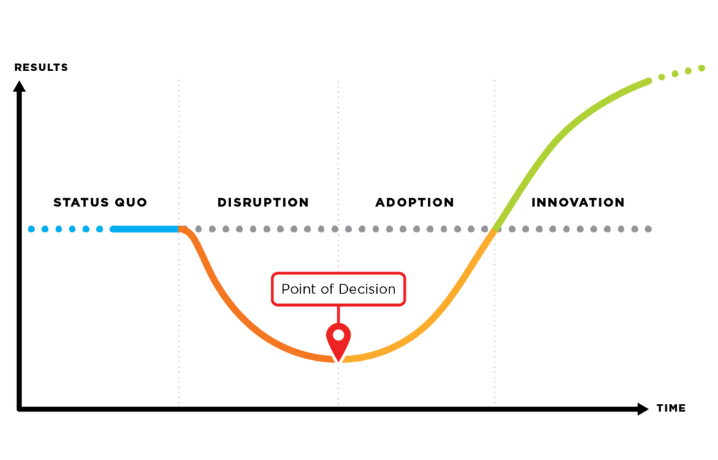
The Zone of Innovation is a concept first introduced by Michael Raynor, a professor at the Wharton School at the University of Pennsylvania. He defines it as “the place where uncertainty and opportunity meet.”
The FranklinCovey Change Model includes the Zone of Innovation to describe the exciting stage your organization enters once a change has been adopted and stabilized. It’s where you can use your success and what you’ve learned to explore what else to do, what your changes made possible and where else you can go. The Zone of Innovation can be an ideas factory where you can explore opportunities leading to new insights and breakthroughs. But as with any other type of innovation, there’s trial and error involved.
While some companies are more successful than others when it comes to being innovative, there are certain things you can do to improve your chances of success — including curbing your well-earned enthusiasm when you seem to be getting it right.
The change model
 The Zone of Innovation is the stage all leaders dream of reaching when a new change, chosen or imposed, begins to reveal even more possibilities than anticipated. The change has settled, requiring less effort to maintain and freeing up time to refine the results. People are more confident, motivated by the shift and ready to seize the opportunity out of uncertainty.
The Zone of Innovation is the stage all leaders dream of reaching when a new change, chosen or imposed, begins to reveal even more possibilities than anticipated. The change has settled, requiring less effort to maintain and freeing up time to refine the results. People are more confident, motivated by the shift and ready to seize the opportunity out of uncertainty.
However, the model creates forward movement and discernment. Providing a holistic representation of the universal stages of change allows you to pinpoint where you are and where you want to go, track the progress and assess the return on investment of your action. There are four key zones:
1. Status Quo. Assess where we are, what’s happening, what’s working, what’s not and what needs to change.
2. Disruption. Announce the change and engage your people.
3. Adoption. Do the work of change. Learn from setbacks and where they persist.
4. Innovation. Explore. Where has the change taken us? What have we discovered? Assess what’s possible now.
When leaders disregard the framework, they fall into the trap of mistaking intuition for perspective and being reactive when it’s time to be reflective.
Success comes with a stealth tax
We all crave success, which is not a bad thing. But success can come with a stealth tax, one which can be dangerous to your leadership and the company’s long-term health.
Leaders eager to enjoy a successful change often skip past the Zone of Innovation and instead enter a stage of unbridled, premature action. Why does this happen?
Inexperience. The reality is that transforming organizations at scale and pace isn’t something senior leadership has frequent experience doing. One successful change does not an expert in transformation make.
Overconfidence. A 2018 study showed that over 65% of Americans think they have above-average intelligence. “The more successful we are, the more we think we’re right. The endowment effect suggests we overvalue items, ideas and initiatives we own,” MindEquity CEO and Behavioral Scientist Nuala Walsh says.
The cost of overconfidence
When overconfidence takes over, best practices go out the window, leading to a failure to make the cost/benefit analysis of decisions, resulting in new ideas that are expensive and ineffective.
Often, leaders take the early rewards of change as validation, as a sign it’s safe to continue an upward trajectory. But the change model includes curves for a reason. If the surge of innovation doesn’t eventually slow, stabilize and internalize as the new normal, then we’re left with a vertical line ─ one that is impossible to climb.
Change – every change — is a pattern
Using successful change as the impetus to fuel further change is everything the Zone of Innovation stands for. However, the danger of stopping before entering the Zone of Innovation or entering while high on success is that you need to give new changes and decisions the same level of attention and scrutiny. This can lead to impulsive communication, spending and hiring ─ everything that can undo the progress you and your people have made.
Successful change leaders must think more extensively than their current systems to reach new heights of performance. They must empower their teams to look for new solutions and possibilities actively. However, this doesn’t mean acting without planning. Each evolution, process change and idea requires the pre-work of creating a compelling vision that helps you engage your team. You must complete that pre-work to avoid losing the results you gained and alienating the people who make it happen.
Executive teams must avoid the mindset of “we are so brilliant and good at what we do” after implementing a successful change. Following and leveraging the predictable pattern of change instead of raw intuition made you wise. Managing the human responses to that change empowers the best in your people. Engaging those closest to the work in the innovation made you successful!
Stabilize before trying to soar higher
Effective decision-making in change requires emotional neutrality, which can be challenging to achieve without an objective framework. Giving the same level of effort, conscious thought and self-awareness to all opportunities that arise while in the Zone of Status Quo and the Zone of Innovation is what unlocks the magic of the change model.
It’s not that you shouldn’t celebrate your successes or even disallow them from influencing future decision-making. Instead, you must know how success can impact your ability to think critically about change.
Let success fuel your innovation. Let it guide you. But don’t let success blind you.
Curtis Bateman is FranklinCovey’s vice president of international direct offices, a co-author of “Change: How to Turn Uncertainty Into Opportunity,” and a content expert on FranklinCovey’s course of the same name. Bateman has over 25 years of experience in the training industry and is an internationally recognized keynote presenter, content developer, change consultant, business leader and coach.
Opinions expressed by SmartBrief contributors are their own.
_______________________________
Subscribe to SmartBrief’s FREE email newsletter on leadership. It’s among SmartBrief’s more than 250 industry-focused newsletters.
